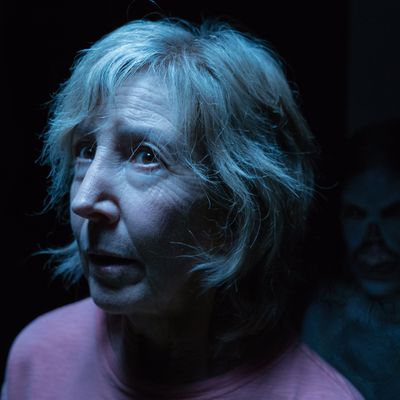
I regret to report that I didn’t understand most of what happens in Insidious: The Last Key. Several successful genre films in recent months have been criticized as playing fast and loose with their own fantastical in-film logic (It, Star Wars: The Last Jedi) but the fourth installment of Leigh Whannell’s ghost-and-mediums horror series wraps up its own free-association illogic with an impenetrable tangle of woo-woo spirit-world mechanics and lingo. There is a real chance that one might be too busy trying to piece it all together to notice the jump scares, the film’s prime mode of horror-stirring.
It opens with a peek into the origins of Elise Rainier, the medium played by Lin Shaye who has been a constant throughout the franchise. She’s growing up just down the road from a federal penitentiary that executes inmates daily, providing plenty of malevolent spiritual material that keeps young Elise (Ava Kolker) and her brother Christian (Pierce Pope) up at night. Dad doesn’t believe in or approve of her abilities; Mom tells her she’s just a little different. Then one night Elise is lured to the basement by a spirit, who convinces her to open a (physical) door that opens a (spiritual) floodgate of evil ghosts, one of whom kills her mother.
How this plays into the present-day story, in which Elise, prior to the events of the first Insidious, is hired to ghost-hunt her own childhood home by its current occupant, should be satisfying enough. But the nature of the haunting, and director Adam Robitel’s questionable handle on the tone gives the impression of a film that was shot blindly, literally as each page of the script was printed out. There are many puns. Worse, the ghoulish revelations never land as they should, because they come out of nowhere. The central demon, a spindly ghoul with keys on the ends of his spindly fingers that can lock his victims voices and consciousness away is a splendidly creepy creation, but could have shown up in any movie. We never find out what his other three fingers do, which seems like an oversight.
Still, it’s nice to see a horror series confident enough to make its evil-fighting heroine a woman of a certain age, rather than confine such a character to ominous grandma status. And Shaye is eminently rootable in the demon-dimension scenes, even if other scenes come off more stilted. She feels like she belongs in this confounding universe; Bruce Davison (!), who shows up to play present-day Christian, does not. The film hints at a torch-passing to a younger generation of ghost hunters, which will be a shame; the world needs more final golden girls, ideally with stronger material to work with.

